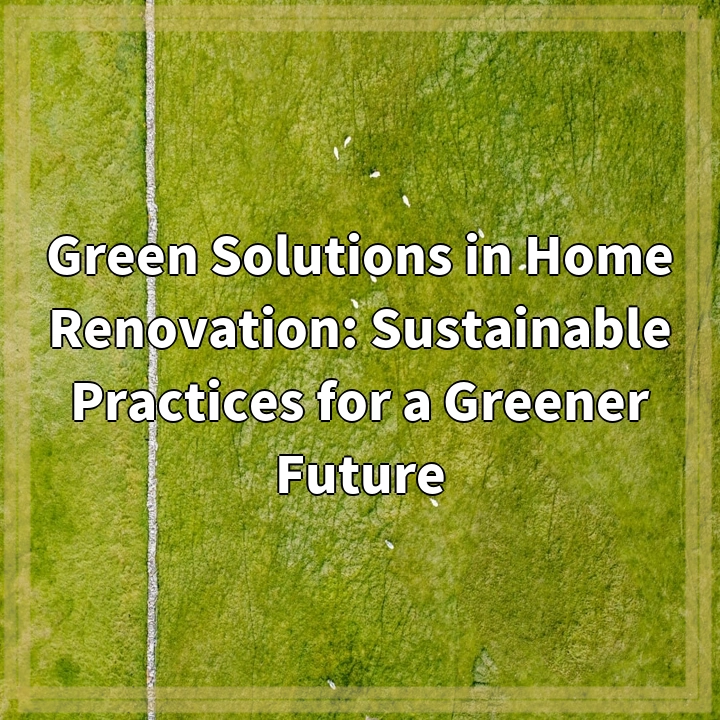
What it is:
Green solutions in home renovation refer to sustainable practices that aim to minimize environmental impact while enhancing the functionality and aesthetics of living spaces. These practices encompass the use of eco-friendly materials, energy-efficient designs, and resource conservation methods. Homeowners and renovators are increasingly seeking ways to incorporate green solutions, which can range from sourcing sustainable building materials such as reclaimed wood or bamboo to installing energy-efficient appliances, solar panels, and water-saving fixtures.
Real-world problems
Despite the growing awareness of green solutions in home renovation, several real-world problems can hinder the widespread adoption of these practices:
High Initial Costs
Many sustainable materials and technologies can have higher upfront costs compared to conventional options. This can deter homeowners, especially those on tight budgets, from implementing green solutions in their renovation projects.
Lack of Awareness and Education
A significant barrier to adopting green renovation practices is the lack of awareness among homeowners. Many people are simply not informed about the benefits of sustainable options or may not know where to find them. Educational initiatives can help bridge this gap, but there is still a long way to go.
Limited Availability of Sustainable Materials
Though the market for eco-friendly materials is expanding, access can be an issue. In many regions, sustainable materials may not be readily available, forcing homeowners to settle for traditional options that may not align with their green renovation goals.
Regulatory Challenges
Building codes and regulations may not always support innovative green practices. In some cases, zoning laws can restrict the installation of renewable energy technologies, such as solar panels, limiting renovation options for homeowners aiming for sustainability.
Performance and Durability Concerns
Some homeowners may fear that eco-friendly materials or technologies won’t perform as well as their traditional counterparts. There may be concerns about durability, maintenance, and lifespan, which can lead to reluctance in choosing green solutions over familiar, conventional ones.
Resistance to Change
Homeowners may have preconceived notions about renovation processes and materials, leading to resistance to change. Overcoming this mindset requires extensive education and demonstrated success stories to instill confidence in adopting green practices.

Solutions to Implement Green Solutions in Home Renovation
Addressing the challenges of integrating green solutions in home renovation requires a multi-faceted approach. Here are some practical solutions that can help overcome the barriers associated with sustainable practices:
1. Financial Incentives and Grants
Government programs and local organizations can offer financial incentives, rebates, and grants to homeowners who choose eco-friendly renovation options. These financial aids can significantly reduce the initial costs associated with sustainable materials and technologies, making green solutions more accessible.
2. Educational Campaigns
Implementing educational initiatives can increase awareness of green renovation practices. Workshops, webinars, and online resources can inform homeowners about the benefits of sustainable options and how to implement them effectively. Providing case studies showcasing successful green renovations can inspire others to follow suit.
3. Improved Access to Sustainable Materials
Building partnerships with local suppliers can enhance the availability of sustainable materials. Encouraging the establishment of eco-friendly building material suppliers and collaborating with businesses that specialize in green products can create a more extensive network for homeowners.
4. Advocacy for Policy Changes
Advocating for changes in building codes and regulations can pave the way for more robust support for green renovations. Engaging with local government to promote policies that encourage the use of renewable energy sources and sustainable construction practices will help create an environment more conducive to green solutions.
5. Demonstrating Success Stories
Highlighting successful green renovation projects can help alleviate concerns about performance and durability. Sharing testimonials, before-and-after photos, and detailed accounts of the benefits enjoyed by homeowners who have opted for sustainable solutions can motivate others to make greener choices.
6. Encourage a Cultural Shift
Promoting a cultural shift toward sustainability in home renovation can inspire homeowners to embrace change. Community events focusing on eco-friendly living, sustainable practices, and the importance of environmental stewardship can foster a mindset that values green solutions as a norm rather than an exception.















